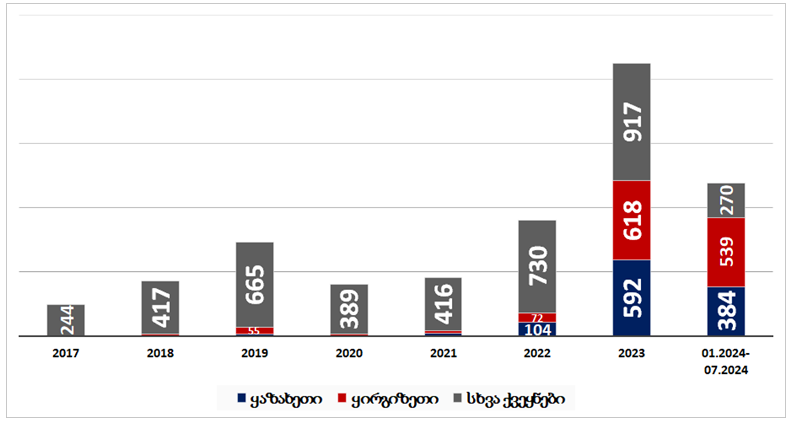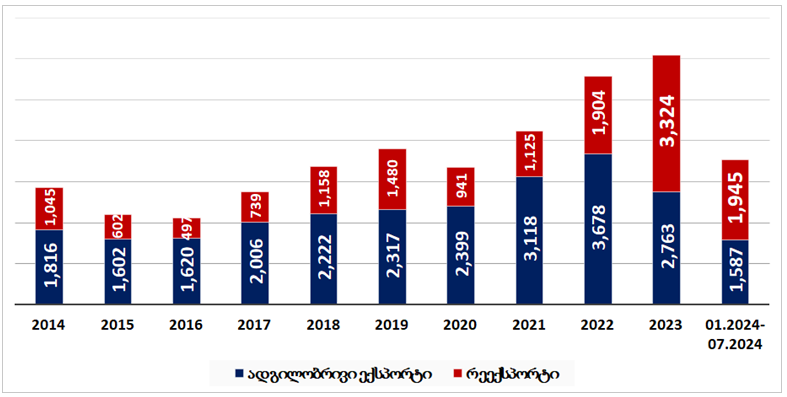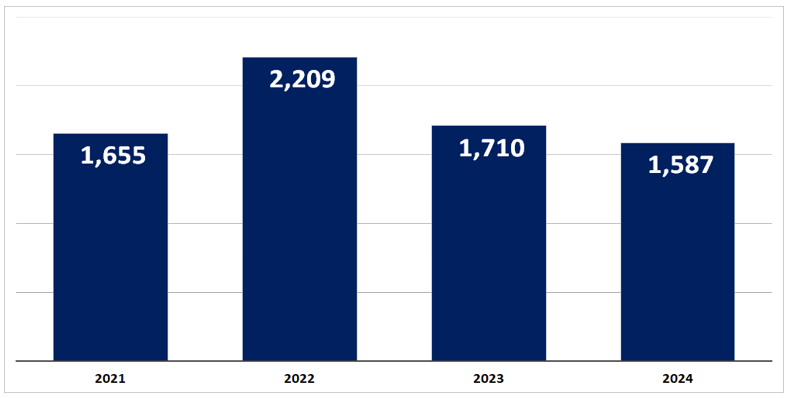Government of Georgia: “Exports and trade turnover reached a new record high in July.”
Verdict: FactCheck concludes that the statement by the government of Georgia is HALF TRUE.
Exports reached USD 685 million in July 2024, representing a new record high on a monthly basis and a 30% increase as compared to the same period last year. Moreover, trade turnover also marked a historic high of USD 2.1 billion in July.
However, exports declined by 1.3% to USD 3.5 billion over the seven-month period, whereas domestic exports (exports excluding re-exports) decreased by an even larger margin of 7.2%, totalling USD 1.6 billion. Notably, domestic exports are more crucial for economic well-being than re-exports.
Domestic exports have exhibited a declining trajectory over the past year and a half. Particularly, less domestic products were sold internationally in the January-July period of the current year, not only compared to the same period last year but also compared to the same period in 2021. Considering the statistical accuracy of the figures stated but the omission of additional key factors, FactCheck concludes that the statement by the government of Georgia is HALF TRUE.
Analysis
The government of Georgia shared a post on its official Facebook page highlighting foreign trade figures and stating: “Trade turnover reached USD 2102.5 million which marks a 13.6% increase as compared to the same period of the previous year, representing a record volume like exports.
Trade turnover increased by 1.6%, reaching USD 12564.5 million from January to July 2024.”
Georgia’s trade balance has consistently been in deficit with imports exceeding exports since 1995. Despite certain exceptions, both exports and imports have exhibited growth trends, resulting in increased overall trade turnover throughout the analysis period.
Exports experienced a substantial increase of 30%, reaching USD 685 million in July as compared to the corresponding period last year. The increase in trade turnover amounted to 14%, totalling USD 2.1 billion. Both exports and total trade turnover reached record levels whilst imports were only slightly below the record figure marked in April.
Despite the record highs observed in July, exports declined slightly by 1.3% over the first seven months of the current year as compared to the same period last year. Exports saw a decline in four out of the previous seven months.
The decrease in domestic exports was even more pronounced than the overall export during this period, with a 7.2% decline bringing the total to USD 1.6 billion. Although domestic exports also saw an increase of 18% in July, constituting USD 293 million, this figure does not represent a record high. Notably, the domestic export figures exceeded the aforementioned amount in eight months in 2022.
Kyrgyzstan ranked first amongst overall export destinations over the past seven months with exports amounting to USD 587 million. Re-exports represented 99% of the aforementioned amount or USD 580 million. Furthermore, light vehicles accounted for USD 538 million of these re-exports.
The business of re-exporting light vehicles began to pick up in 2005. Whilst light vehicles made up 0.6% of total exports in 2004, the share grew to 2.1% in 2005, surpassed 13% in 2010 and reached 24% in 2012, marking a historic peak. Although the share remained substantial in the following years, it did not exceed the 20% mark before Russia’s invasion of Ukraine. The share had increased to 35% by 2023 and now stands at 34% for the January to July period of this year.
The total share of Kazakhstan and Kyrgyzstan in car exports averaged 4.9% from 2017 to 2021. This combined figure increased to 19% by 2022, later to 57% by 2023 and further rose to 77% in the first seven months of 2024.
Graph 1: Car Exports (USD Million)

Source: National Statistics Office of Georgia
GeoStat has been independently recording data for exports and re-exports since 2014. Domestic exports consistently averaged 70% from 2014 to 2021; however, this share fell to 45% by 2023. This trend has continued in the January-July 2024 period. Notably, domestic exports had never dropped below the 61% mark prior to 2023.
An increase in the share of domestic exports would not have been as concerning if it had been a result of an increase in its monetary value. However, domestic exports have also decreased at the same time as the increase in re-exports. Domestic exports declined significantly by USD 915 million in 2023 as compared to 2022, representing a 25% drop. This downward trend persisted in 2024 with a further USD 124 million decline in the number of commodities sold in the first seven months of the year as compared to the same period in 2023. Domestic exports from January to July in the current year did not even reach the levels recorded in 2021. The key issue is the sharp decline in domestic exports rather than simply the increase in re-exports.
Graph 2: Structure of Exports (USD Million)

Source: National Statistics Office of Georgia
Domestic exports have been exhibiting a declining trend over the past year and a half, primarily due to the reduced demand for copper ores and ferroalloys. Exports of copper ores have dropped substantially from USD 1 billion to USD 474 million, whereas ferroalloy exports dropped from USD 453 million to USD 181 million in 2023. Additionally, exports of nitrogen fertilisers decreased from USD 281 million to USD 158 million.
The situation with copper ore exports deteriorated even further in the first seven months of the current year, with exports further decreasing by USD 345 million, resulting in copper ore no longer being amongst the top ten export products despite ranking the first previously. Declines were also observed in exports of nitrogen fertilisers and electricity. Despite an 80% increase in the export of ferroalloys as compared to its decline in the previous year, as well as wine exports reaching a historic high, these expansions were not enough to offset the drop in copper ore exports.
Graph 3: Domestic Exports from January to July (USD Million)

Source: National Statistics Office of Georgia
Whilst China ranked first in domestic exports due to its demand in copper ores from 2020 to 2022, it dropped to the third place with Russia taking the top spot, accounting for over 20% of domestic exports in January-July.
Although re-exports also impact the economy, domestic exports have a greater influence in terms of employment and the contribution of tax revenue to the state budget. Hence, the decline in domestic exports cannot be deemed as an insignificant factor, regardless of the underlying reasons.
Whilst both export and trade turnover reached record figures in July, exports have slightly decreased over the past seven months. Furthermore, domestic exports have exhibited a declining trajectory over the past year and a half. Particularly, less domestic products were sold internationally in the January-July period of the current year, not only compared to the same period last year but also compared to the same period in 2021. Considering the statistical accuracy of the figures stated but the omission of additional key factors, FactCheck concludes that the statement by the government of Georgia is HALF TRUE.








